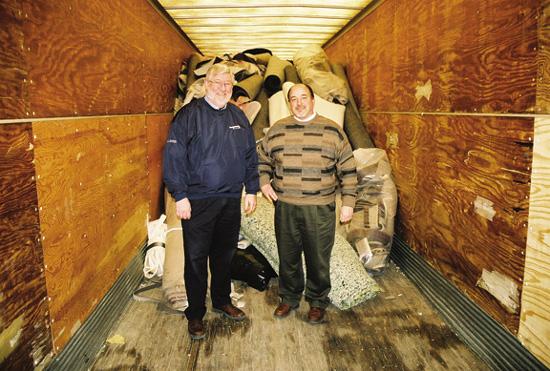Best Practices - October 2009
By Sonya Jennings
What began as Sergenian’s rug cleaning business in 1930 has blossomed into a successful floorcovering store serving commercial, builder, and retail clients in the Madison, Wisconsin area. About half of the company’s business is commercial, and the other half is split between retail and builder customers. CEO Jim Garner believes that a business must differentiate itself in order to survive long term, and since the early ’90s, one of the ways that Sergenian’s has achieved this goal is through recycling and reclamation efforts. In the college town of Madison, environmental concerns are an important issue. Sergenian’s promotes and educates the public about this program through advertising, And its many successes help create the best advertising of all; word of mouth.
In the beginning, Sergenian’s recycling effort was a hit or miss program because there were no reliable avenues to process all of the company’s old carpet and pad. Nevertheless, the interest in recycling and reclamation grew at Sergenian’s. Other companies tried to follow Sergenian’s lead but met with little success. Sergenian’s continued to search for consistent recycling avenues until 2006 when Garner found Reynolds Urethane Recycling in Middleton, Wisconsin. This company had the ability to take most of Sergenian’s carpet, pad, and scraps, which allowed Sergenian’s to recycle most of its waste.
With the recycling program came intense training for the company’s sales, administration, warehouse, and installation employees. Everyone had to learn how to recycle everything. For example, teaching installers that everything must be separated, and that even carpet scraps had to stay out of the dumpster, presented a new learning curve. The habit of “throwing it in the dumpster” had to be broken if the company’s goal of sending nothing to the landfill was to be reached.
Through further research, Garner found other companies such as Kruse, Interface, and Covanta that would take the few items that Reynolds couldn’t process. He basically created a web of companies to guarantee that everything the company was taking out of homes and businesses could be recycled.
When Sergenian’s performs a large job at a commercial office space, it awards the business a plaque that highlights the pounds of material kept out of the landfill. The certificate comes from Starnet Flooring Alliance and CARE (Carpet America Recovery Effort).
If Sergenian’s wins a partial job, it’s often the tear out portion of the job because the client knows that all of the material will be recycled. In this case, Sergenian’s charges the client an additional fee for the processing of the material. Also, anyone can drop off carpet and pad from a do-it-yourself project. There are specifications as to how the old carpet is to be prepared (cut into 9’x9’ sections). Once the customer prepares the waste, Sergenian’s sends it off to the appropriate recycling companies.
Our recycling program is absolutely more costly than putting the old carpet and pad in the dumpster,” Garner says. “But first and foremost, it’s the right thing to do.” He also points out that Madison is a fairly liberal town, and that customers know where to shop if they have an environmental impact concern. Also, the design community understands the company’s reclamation philosophy. Sergenian’s spreads the word about its sustainability program through heavy advertising. The company has ads that only focus on explaining the company’s recycling efforts and accomplishments, and don’t mention a single product.
In addition to recycling old carpet and pad, the company recycles just about everything possible. Paper, cardboard, and many other office products are recycled. This has reduced paper costs by 20%. Sergenian’s also challenges manufacturers to create ways to help in the conservation efforts, and Garner seeks out new and innovative products to try that match the company’s environmental philosophy. For instance, the company just installed a polyester carpet tile test product that is 100% recycled material. If it performs as expected, Sergenian’s will carry the product. Also in the testing phase is a pad that is made of 80% post consumer recycled material and 20% post industrial recycled material.
Sergenian’s was also named one of seven companies in Madison to be part of a group called “M Powering.” These seven companies are recognized for recycling efforts that go beyond expectations. They take part in an energy audit and commit to reducing their impact on the environment any way they can. With this comes local publicity that’s helpful in gaining new environmentally conscious customers. Employees try to do their part personally by riding their bikes to work on Thursdays.
Besides the recycling effort, another big push for the company is connecting to customers through social networking sites like Facebook and Twitter. This effort is led by Nick Sergenian, the son of one of Sergenian’s co-owners. Garner points out how important it is to speak to younger clients in order to keep the business thriving long-term.
Sergenian’s carries area rugs, hardwood, laminate, ceramic, stone, granite countertops, carpet, and window treatments. The company focuses on the mid to high-end price points. Sergenian’s is still partially owned by the Sergenian family along with Garner, who joined the company in 1963.
Copyright 2009 Floor Focus
